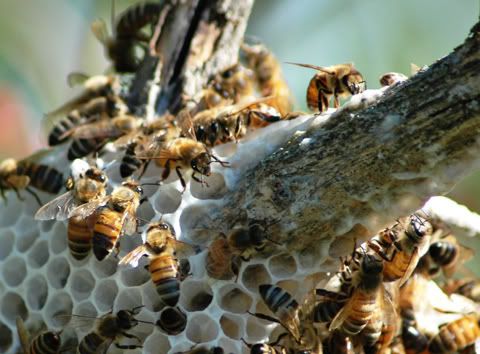
Last weekend there was an opportunity to drive out the road that follows Big Rock Creek south outside of the town of Big Rock. This is where I'd found the wild hive on a walking photography mission at the end of May.
I felt more confident about inching halfway down the steep embankment, whose base was now fully hidden by the thick cover of roadside weeds. Registered in my memory was the basic pitch and shape of the hillside and now I had the help of the sturdy and well established weeds to hold onto if I felt myself slipping.
My knowledge of bees and insects in general is lacking, and it occurred to me that I should probably read up on their behavior. Last time the bees were frantically at work building a hive. Their activity was single minded and their work seemed guided by a general consensus of what needed to be done. With that in mind as I inched down the incline, I was shocked at the hives current state of activity.
The bees were sluggish, almost as if they were drugged. The hive didn't seem any larger or any nearer being completed than the last time I visited. The hive, which was more visible, seemed to be consructed of a styrofoam-type substance, instead of the waxy material I expected to see. And most surprising of all was the appearance of the bees themselves. This time they all seemed to have developed a round waxy/translucent spot just behind their head - almost the appearance of a blister. How curious.
So now I'm off to research the bee and try to determine what has gone wrong with this hive. None of the cells are filled and it seems to be an exercise in futility. Was the queen destroyed?
1 comment:
http://creatures.ifas.ufl.edu/misc/bees/varroa_feeding2.htm
Varroa mites maybe?
Post a Comment